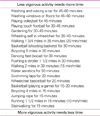1. Fletcher GF, Blair SN, Blumenthal J, Caspersen C, Chaitman B, Epstein S, Falls H, Froelicher ES, Froelicher VF, Pina IL. Statement on exercise: benefits and recommendations for physical activity programs for all Americans: a statement for health professionals by the Committee on Exercise and Cardiac Rehabilitation of the Council on Clinical Cardiology, American Heart association. Circulation. 1992. 86:340–344.

2. Jeong YH, Seo MK, Lee JT, Jeong HS, Koh SJ, Chae SM, Kim MH. Analysis of health determinants of Korean. 2006. Seoul: Korea Institute for Health and Social Affairs, Management Center for Health Promotion.
3. Korea Centers for Disease Control and Prevention. In-depth analyses of the Third National Health and Nutrition Examination Survey: the health interview and health behavior survey part. 2007. Seoul: Korea Centers for Disease Control and Prevention.
4. Medical Law of Republic of Korea. No. 9386. Article 2. [modified 2009 Jan 30].
5. American College of Sports Medicine. ACSM's guidelines for exercise testing and prescription. 2010. 8th ed. Philadelphia: Lippincott Williams&Wilkins/Woltes Kluwer Health Inc..
6. U.S. Department of Health and Human Services. Centers for Disease Control and Prevention. National Center for Chronic Disease Prevention and Health Promotion. President's Council on Physical Fitness. Physical activity and health: a report of the surgeon general. 1996. Sudbury, MA: Jones and Bartlett Publishers.
7. Public Health Agency of Canada. Canada's physical activity guide to healthy active living. 1998. Ottawa: Public Health Agency of Canada.
8. Department of Health and Ageing of Australian Government. National physical activity guidelines for Australians. 1999. Canberra: Department of Health and Ageing of Australian Government.
9. Western Pacific Regional Office of World Health Organization. Pacific physical activity guidelines for adults. 2008. Manila: Western Pacific Regional Office of World Health Organization.
10. Ministry of Health of New Zealand. DHB toolkit: physical activity. 2003. Wellington: Ministry of Health of New Zealand.
11. Koh KW, Lee MS, Kim DK, Park EJ, Jo EJ, Kim HS, Song SE, Kim YJ, Kim JM. Korean strategies for promotion of health enhancing physical activity. 2007. Busan: Kosin University, Management Center for Health Promotion.
12. Koh KW, Park JB, Kim Y, Bae SK, Yee YH, Yoo BC, Jeon MJ, Jo EJ, Song SE, Kim YJ, Kim JM. Developement of active living strategy through lifestyle approach. 2006. Busan: Kosin University, Management Center for Health Promotion.
13. Koh KW, Yee MW, Kim YJ, Park JS, Song SE. Construction of physical activity information system for community health initiatives. 2003. Busan: Kosin University, Management Center for Health Promotion.
14. Koh KW, Park JS, Kim MA, Kim JH, Jo EJ, Song SE. Developement of physical activity promotion program through capacity building by leadership and participation. 2005. Busan: Kosin University, Management Center for Health Promotion.
15. American College of Sports Medicine. The recommended quantity and quality of exercise for developing and maintaining fitness in healthy adults. Med Sci Sports Exerc. 1978. 10:7–10.
16. U.S. Department of Health and Human Services. Physical Activity Guidelines Advisory Committee report. 2008. Washington, DC: US Department of Health and Human Services.
17. Pate RR, Pratt M, Blair SN, Haskell WL, Macera CA, Bouchard C, Buchner D, Ettinger W, Heath GW, King AC, Kriska A, Leon AS, Marcus BH, Morris J, Paffenbarger RS Jr, Patrick K, Pollock ML, Rippe JM, Sallis J, Wilmore JH. Physical activity and public health: a recommendation from the Centers for Disease Control and Prevention and the American College of Sports Medicine. JAMA. 1995. 273:402–407.

18. Department of Health. At least five a week: evidence on the impact of physical activity and its relationship to health. 2004. London: Department of Health, Physical Activity.
19. National Institute of Health and Nutrition. Exercise and Physical Activity Reference for Health Promotion 2006 (EPAR 2006): physical activity, exercise, and physical fitness. 2006. Tokyo: Ministry of Health, Labour and Welfare of Japan.
20. World Health Organization Western Pacific region. Pacific physical Activity Guidelines for adults. 2008. Manila:
21. U.S. Department of Health and Human Services. 2008 Physical Activity Guidelines for Americans. 2008. Washington, DC: U.S. Department of Health and Human Services.
22. U.S. Department of Health and Human Services. Centers for Disease Control and Prevention. National Center for Chronic Disease Prevention and Health Promotion Division of Nutrition and Physical Activity. Promoting physical activity: a guide for community action. 1999. Champaign: Human Kinetics.
24. Yang YJ, Jin YS, Cho SI, Kim YS, Park RH. Development of physical activity questionnaire and guideline for Korean adults. 2007. Management Center for Health Promotion.
25. Paffenbarger RS Jr, Hyde RT, Wing AL, Hsieh CC. Physical activity, all-cause mortality, and longevity of college alumni. N Engl J Med. 1986. 314:605–613.

26. Blair SN, Kohl HW 3rd, Paffenbarger RS Jr, Clark DG, Cooper KH, Gibbons LW. Physical fitness and all-cause mortality: a prospective study of healthy men and women. JAMA. 1989. 262:2395–2401.

27. DeBusk RF, Stenestrand U, Sheehan M, Haskell WL. Training effects of long versus short bouts of exercise in healthy subjects. Am J Cardiol. 1990. 65:1010–1013.

28. Ebisu T. Splitting the distance of endurance running: on cardiovascular endurance and blood lipids. Jpn J Phys Educ. 1985. 30:37–43.

30. U.S. Department of Health and Human Services. Be active your way: a guide for adults based on the 2008 physical activity guidelines for Americans 2008. 2008. Washington, DC: U.S. Department of Health and Human Services.
31. Ministry of Health, Labour and Welfare of Japan. Exercise and physical activity guide for health promotion 2006. 2006. Tokyo: Ministry of Health, Labour and Welfare of Japan.









 PDF
PDF ePub
ePub Citation
Citation Print
Print



 XML Download
XML Download